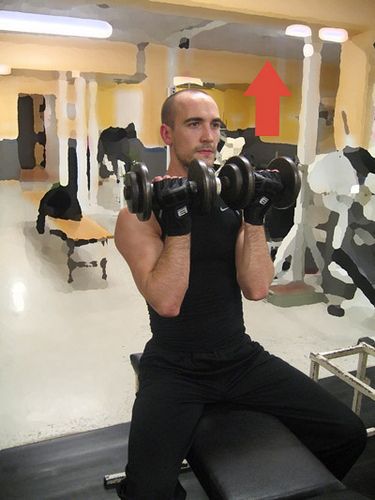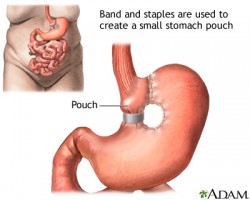How to Lose Weight Before School
An approaching new school year always feels like an opportunity to present a new you. For many young adults, teens, and even kids, losing weight is the desired goal before school starts up again. Resist the temptation to wait until the last minute and then try to shed several pounds quickly (and unhealthily, and unsustainably). Your best bet for a healthy, happy, and successful weight loss program before school starts is to start early, follow healthy guidance on diet and exercise, and build a support network that can help you achieve your sensible goals.
Steps
Part 1 Establishing Limits, Goals, and Needs
-
1
Consult an expert. Losing weight is not always healthy, and in fact can be quite harmful if you are already at a healthy weight or rely on inadvisable methods. Talking to a doctor or registered dietician before embarking on a program is the best way to set the proper goals and methods for your healthy weight loss.
[1]
- Peer pressure and body image issues can make school-age young people particularly susceptible to mistaken beliefs that they need to lose weight. If you are healthy just the way you are, focus only on maintaining that health.
- If you do need to lose weight, don’t focus on a set number, or trying to look just like some famous person or popular schoolmate. Instead, establish with a professional what your healthy weight range should be and how best to reach it.
-
2
Be realistic. You may want to believe that there is some miracle fix that will let you shed five pounds in the week before school starts. But any fad diet that promises such results is either a lie or detrimental to your health.
[2]
- Also, even if they do work temporarily, quick-fix diets don’t produce lasting results.
- Aiming to lose one, and possibly at most two pounds per week is the only healthy option for most people. Consult your doctor or dietician.
-
3
Give yourself time. If you really want to lose weight before the new school year starts, your best option is to begin the process as soon as the prior school year ends. The tortoise and the hare weren’t concerned with shedding pounds, but “slow and steady” is definitely the way to win this race.
- If you want to lose weight and keep it off, which should always be the healthy goal, then you need to change your eating and activity behaviors. This takes time, as it requires you to recondition your brain and body.[3]
- Studies have indicated that spending some time trying just to maintain your current weight before actually trying to lose weight can improve long-term results. This provides you an adjustment period for changing behaviors in a less stressful environment.[4]
-
4
Rely on a support network. Weight loss works best when it is not a solo endeavor. Everyone needs a boost, an encouraging word, and a kick in the pants from time to time in order to succeed. Getting family, friends, and trusted advisors involved is your best option.
[5]
- It can be tough to stick with a salad with canned tuna on top when your brothers are inhaling a pizza from your favorite shop. Ask for some understanding as you try to change your habits, or better yet, see if you can get the rest of your family on board.
- It always helps to have someone you trust as a sounding board for those times when your cravings are getting the better of you or your confidence is low. If an organized weight loss program provides the support you need, by all means utilize one.
- You can be part of your own support network by keeping a food diary. Keeping track of what you eat, how much you eat, and why you eat, along with your lifestyle changes, exercise activities, and overall feelings, can help keep you self-motivated.
Part 2 Eating Healthy
-
1
Eat with a purpose. How much of your eating do you do because you are actually hungry? Often, people eat when they’re bored, stressed, or feel pressured or obligated to do so. Reducing calorie intake is critical to weight loss, and eating only when your body needs sustenance is a good step in that direction.[6]
- Look for other outlets to alleviate your stress or boredom. When weight loss is your goal, exercise is great option — jogging, for instance, can clear your head and keeps you away from the junk food cupboard.
- When you do eat, focus on your food and eat slowly. Turn off the TV. Think about what you are eating. Savor each bite. Stop when you are full.
- Giving yourself challenges can also make eating more interactive and limit mindless consumption. For instance, try eating with chopsticks if you aren’t already handy with them.
-
2
Make step-by-step adjustments. Few people can succeed by going “cold turkey,” switching from an unhealthy to a healthy diet overnight. For most, an incremental transition is the best means to long-term weight-loss success.[7]
- Remember, you need time to re-train your mind, body, habits, and taste buds. Be patient.
- Start with small changes. For instance, start by getting the smaller version of your favorite fast-food meal, and get a diet soda instead. Your ultimate goal will be to largely eliminate these items, but incremental reductions in portion size and calorie intake can help you onto that path.[8]
-
3
Drink water. Water is good for everyone, but it can be the dieter’s best friend. It is nourishing, refreshing, and can even be filling, without adding a single calorie to your intake.
- Unless you have a specific need for the nutrients in sports drinks, sticking to water is the simplest and lowest calorie (as in zero calorie) way to hydrate effectively.[9]
- Always drink a glass of water before you eat something. Often, when people think they are hungry, they are actually just thirsty. Water, and perhaps just a small, healthy snack, can be enough to see you through to your next meal. Water can also limit the amount you actually eat at that meal.
-
4
Eat seasonally and smartly. Generally speaking, if you’re looking to lose weight before school starts, that means it’s summertime. Thankfully, summer is the ideal season to seek out fresh fruits and vegetables, which need to be at the heart of your healthy diet.[10]
- Don’t think of summer as a time to indulge in junk, but rather as the time to take advantage of nature’s bounty.
- Depending on your climate, you can go from emphasizing fresh berries and peas, to peaches and tomatoes, to apples and corn, all the while helping your local farmers and the environment (by cutting out long-haul shipping).
- Whether you can source them locally or not, also add more whole grains, lean proteins (summer is a good time for fishing, for instance), and more fiber-rich foods.
-
5
Snack wisely. With their growing bodies, teens in particular can have the urge to eat almost constantly. Choosing the right snacks to carry you through to the next meal can make a huge difference in the success of your weight-loss plan.[11]
- Make snacks like chips and candy a rare treat. Focus instead of healthy, easy-to-prepare / carry / eat fruits, vegetables, and foods with whole grains, lean protein, and fiber.
- For instance, consider pre-packaging any of the following in small sandwich bags: apple slices with peanut butter and raisins; grapes and string cheese; trail mix; edamame; or hummus spread inside a whole-wheat pita. The options are nearly endless, and by packaging them yourself, you'll reduce your inclination to head for the vending machine or candy drawer when hungry between meals.
-
6
Indulge occasionally. Diets that feel like punishment are doomed to fail. The goal is to retrain yourself to see treat foods (double-fudge brownies or double cheeseburgers, for example) as just that — occasional treats and not signs of failure.
- Don’t make any of your favorite foods completely “off-limits.” You’ll only obsess about them more and feel even worse if you do slip up. Focus on practicing portion and frequency control with unhealthy food options.[12]
- When you do choose to indulge, savor every bite of that pecan turtle sundae. Eat slowly and deliberately, making every bite count. Make it last so you won’t need to repeat the process again too soon.[13]
Part 3 Staying Active
-
1
Stay on a schedule. If you’re on summer break, it’s easy to think of it as a temporary liberation from schedules. However, planning and regimentation are the allies of practically every successful weight-loss plan.
- Set a summertime goal for yourself; ideally one that supports your weight-loss goals. For instance, pledge that you’re going to learn to rollerblade or be able to swim more laps than your sister.[14]
- Keep your meals, snacks, and exercise time on a fairly consistent schedule. This makes it easier to track your progress and more difficult to make excuses for skipping out.
- Get regular and sufficient sleep, but not excessive. Lazing away your summer is not a good weight-loss plan.[15]
-
2
Work up a sweat. Unfortunately, tanning poolside does not meet this goal. You should strive to be physically active for at least sixty minutes every day.
- If you are sweating at least a bit and breathing hard enough that it is a challenge to make conversation, then you are probably exercising at a beneficial level.
- The sixty minutes of exercise does not have to happen all at once. Three twenty minute sessions seem to be just as beneficial as one sixty minute session.
- Organized sports like soccer, swimming, and tennis fit the exercise bill. So to do activities like dance and aerobics classes. Though usually less of a calorie-burner, yoga also can benefit both body and mind as part of a weight-loss regimen.[16]
-
3
Beat the heat. Especially if it gets oppressively hot where you live, it can be dangerous to engage in otherwise beneficial exercise during mid-day. If it’s too hot to go for your regular jog, adapt your schedule or find an alternative (but healthy) activity.[17]
- Staying hydrated by drinking water is good for your weight-loss plan, but it is also especially important during hot stretches. Hydrate before, during, and after exercising. Plain old water is generally more than sufficient, and comes without all the calories and what-not of sports drinks.
- In especially hot weather, either plan your exercise for early in the morning or later in the evening, or move your exercise indoors. Instead of biking, go to a spinning class, for example. Switching things up occasionally helps retain an interest level anyway.
-
4
Make use of your time. If you’re lucky, you probably have a bit more free time during your break from school than you will once classes start back up. You can take advantage of being in less of a hurry. [18]
- Don’t drive when you can walk (or ride a bike). Sure, it’s less than a five minute drive to your friend’s house, but making it a brisk twenty minute walk (forty round-trip) will fulfill much of your minimum activity goal for the day.
- Take the stairs. Make the elevator your last resort.
- Turn your pre-back-to-school activity time into some extra cash. Mow your neighbors’ lawns. Walk (or jog) some local dogs. Join a house painting crew, or help clean up the local park. Enjoy the great outdoors, look a bit trimmer, and fatten your wallet all at the same time.
-
Weight Loss And You: How To Make It Work
TIP! Eat the recommended amount of calories per day based on
-
How Dangerous Is The Biggest Loser?
I just caught an article in the Guardian newspaper that talks ab
-
Tricks To Help You With Weight Loss
The body is a complex piece of machinery. There are hundreds of proce
-
Weight Loss Tip #24 – Lose weight with haldi or turmeric
-
Weight Loss Information - Create A Successful Diet Plans
When most of the people are decided to lose weight quickly, they are
-
5 Quick Weight Loss Tips
Quick weight loss tips are much sought after by folks eager to lose s
- DON'T MISS
- Astounding White Foods
- Boost Weight Loss With These Simple Tips
- Simple Tips To Help You Be Successful With Weight Loss
- End Your Search For Weight Loss Tips Here
- Here Are 2 Major Weight Loss Secrets They Are Trying to Hide From Us
- How to Take an Inch off Your Waist
- Learn To Lose Weight The Healthy Way Without Dieting!
- Weight Loss Superfoods
- 7 Ways To Lose Weight When Youre Over 60
- Run Faster, Jump Higher: A Guide To Losing Weight




